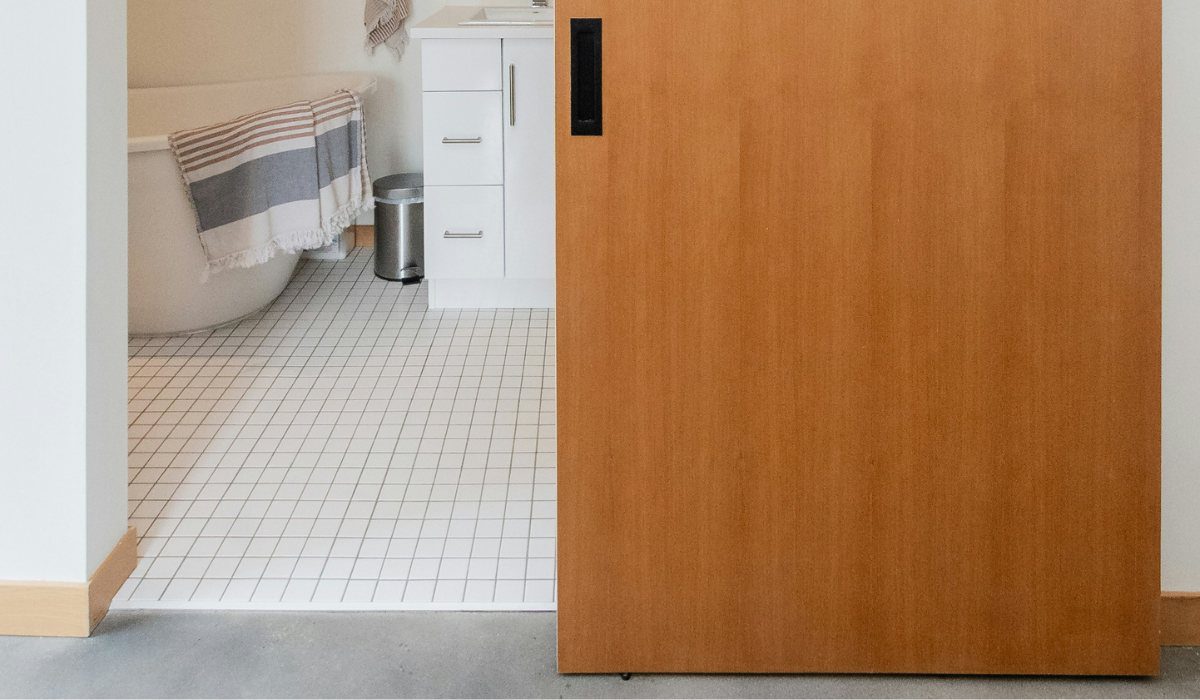For contemporary homeowners with compact living spaces, pocket doors pose as a viable choice when it comes to optimal utilisation of space. These doors use a sliding mechanism for opening and closing and fix neatly into a wall cavity when opened fully. Perfect for indoor usage, these doors don’t compromise on aesthetics either and provide a sleek look to your space. In this article, we delve deeper into the topic of sliding doors and explore if they suit your preferences.
See also: How to install pocket doors?
Types of pocket doors
Pocket doors come in several different types you can choose from depending on your requirements:
Single pocket doors
These doors are made of a single panel that fits into a wall cavity when opened so as to increase floor space for a neat appearance. This is a more practical choice for small areas where swinging doors might take up too much space.
Double pocket doors
These work just like single pocket doors, the only difference being that they comprise two separate panels with separate cavities to create a wide opening between rooms. Alongside providing a wide and airy passageway, these act as a visually appealing architectural element that facilitates a sense of seamless flow between two separate spaces.
Glass pocket doors
The sliding panels of these pocket doors are made of glass. This facilitates ample flow of natural light, while at the same time acting as a visual link between spaces. You can go for the clear glass alternative for a more open feel while frosted glass will ensure your privacy without hampering the sense of space.
Flush pocket doors
The go-to choice of modern-day homeowners, flush pocket doors prioritise sleekness and minimalism by neatly flushing with the wall surface. Moreover, this type of pocket doors offers a plethora of options of designs and finishes and can be customised to suit your tastes and the surrounding decor elements.
Barn-style pocket doors
These doors are perfect if you want to add a rustic charm to your space. They are inspired from traditional barn doors and function by sliding along a mounted track on the top of the doorway. These are widely popular for the aesthetic they add to the space while providing maximum functionality.
Best places to install
The functionality of pocket doors is generally limited to indoor usage. Here are a few places where you can install pocket doors:
Bathrooms
Bathrooms are generally the most compact spaces in the house where optimal utilisation of space becomes super important. Pocket doors facilitate easy access to bathrooms without the need of clearing extra space for a swinging door, thereby also increasing floor area. While they neatly fit into the wall when opened, they provide maximum privacy when shut.
Closets
Pocket doors are a great choice for closet doors, especially in hallways and other narrow spaces. Not only do they provide full access to the contents of the closet, they do not obstruct the surrounding space either.
Home offices
Pocket doors for home offices is a smart choice as it allows flexible usage of space. They provide privacy and quiet to facilitate focused work when closed but create a welcoming ambience and link with the adjacent room when opened.
Dining rooms
Pocket doors can be used to connect dining rooms with kitchen or living spaces. These versatile doors can be opened during large gatherings to provide an expansive space for the ease of entertaining guests. On the other hand, they can be shut for a cosier ambience for intimate setups.
Bedrooms
For bedrooms, pocket doors are a convenient option for entryways or even ensuite bathrooms. They help to eliminate swing interference and when shut, makes the room appear more spacious and airy due to an optimised space utilisation.
Pantries
In kitchen pantries, pocket doors provide easy access to storage locations by minimising the space that would have been occupied by a swinging door. This can prove a useful addition to small but highly busy cooking areas.
Pros and cons
If you are still on the fence about whether or not to go for pocket doors, here is a list of pros and cons to help you decide:
| Pros | Cons |
| By sliding into a wall cavity when not in use, pocket doors result in saving of useful floor and wall space, making them suitable for areas with space restrictions. | The installation of a pocket door in an already existing wall can be a labour-intensive and tardy process involving cutting of walls and interfering with electrical and plumbing systems that are already in place. |
| They provide a clean appearance by seamlessly blending into the wall for a sleek and modern look preferred by many. | Pocket doors are not as efficient as traditional doors when it comes to secure sealing, causing easy passage of noise and odours. |
| They are versatile options that can be used flexibly in the layout of the room by providing privacy when closed and ensuring a smooth flow between adjacent rooms when opened. | To maintain its smoothness, the sliding track of the pocket door requires regular maintenance as accumulation of debris might hamper its functionality. |
| These doors provide a convenient alternative for people with mobility issues and ensures greater accessibility to spaces by eliminating the need for manoeuvring. | Pocket doors are kept lightweight to ensure smooth sliding and avoid straining of the hardware; this can affect the strength and durability of the door. |
Read also: How to install sliding doors?
FAQs
Can pocket doors be installed anywhere in the house?
The suitability of pocket doors for a room depends on the available wall space and the structural integrity. They are most suited for installation in bathrooms, closets and narrow hallways.
Can I fit a pocket door in an existing wall?
While it is possible to install a pocket door into an existing wall, it might require major structural changes to make the required space, such as cutting the wall structure and obstructing electrical and plumbing systems.
How much wall space does a pocket doorway require?
The exact clearance required for a pocket door depends on its engineering specifications but on an average, it requires a wall space that is double its width with a few added inches to enable smooth sliding into the wall.
Are pocket doors soundproof?
Due to the minor gaps in its edges, pocket doors might not provide as efficient soundproofing as traditional doors.
What are the maintenance requirements of pocket doors?
Pocket doors require regular maintenance to ensure smooth functionality, such as cleaning the debris buildup from tracks, lubrication of the sliding mechanism and inspection of damage to the hardware.
Can I install a regular door as a pocket door?
Various types of doors can be used as pocket doors. However, it is recommended to use doors made of lighter materials for smooth sliding as heavier doors might require specific hardware and are not as feasible with the design of pocket doors.
Can pocket doors impact the value of the property?
In places where compact spaces where space optimisation is necessary, pocket doors can prove to be an attractive feature for homebuyers and positively impact the value of the property according to the market value and buyer’s requirements.
| Got any questions or point of view on our article? We would love to hear from you. Write to our Editor-in-Chief Jhumur Ghosh at jhumur.ghosh1@housing.com |







